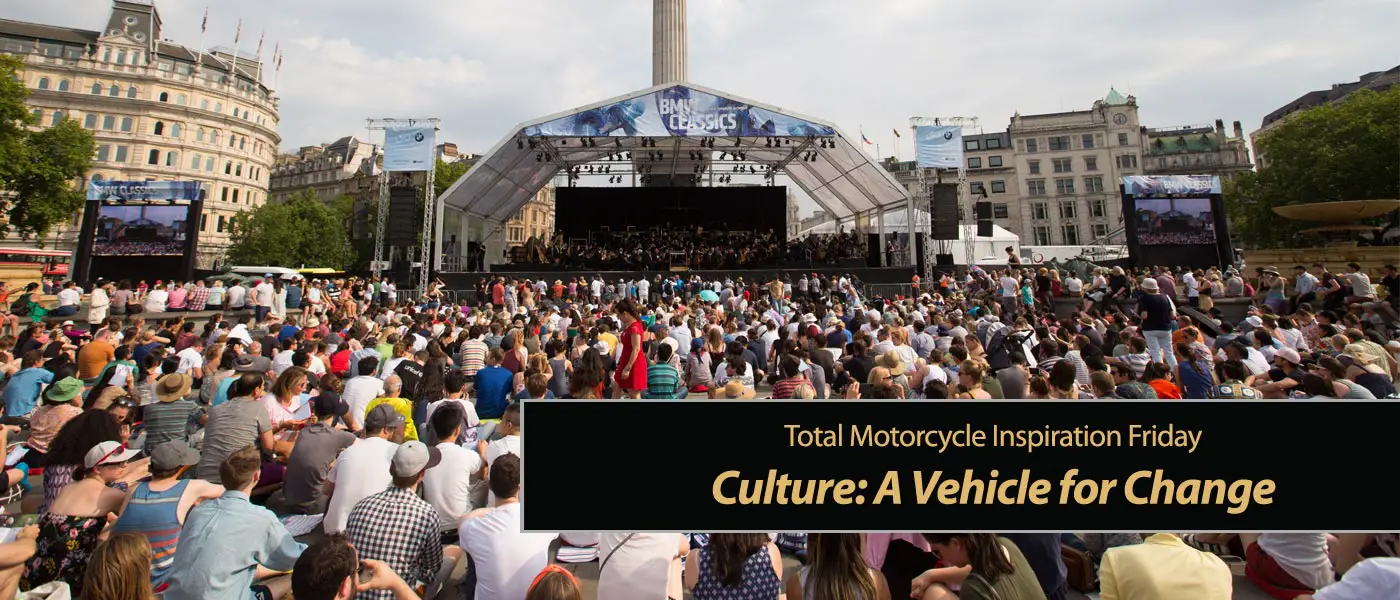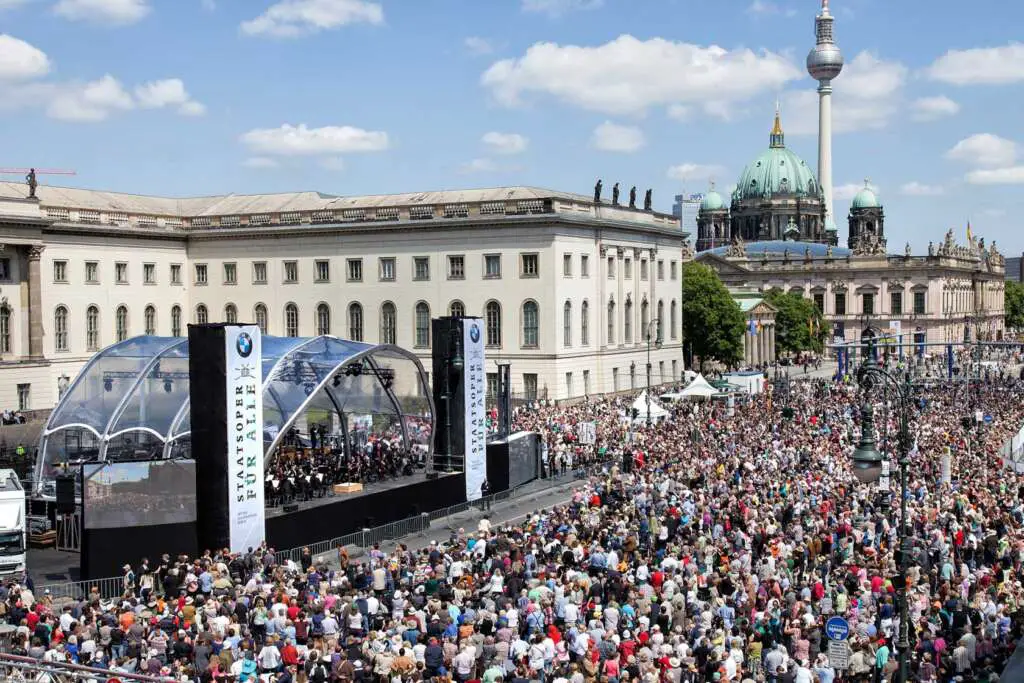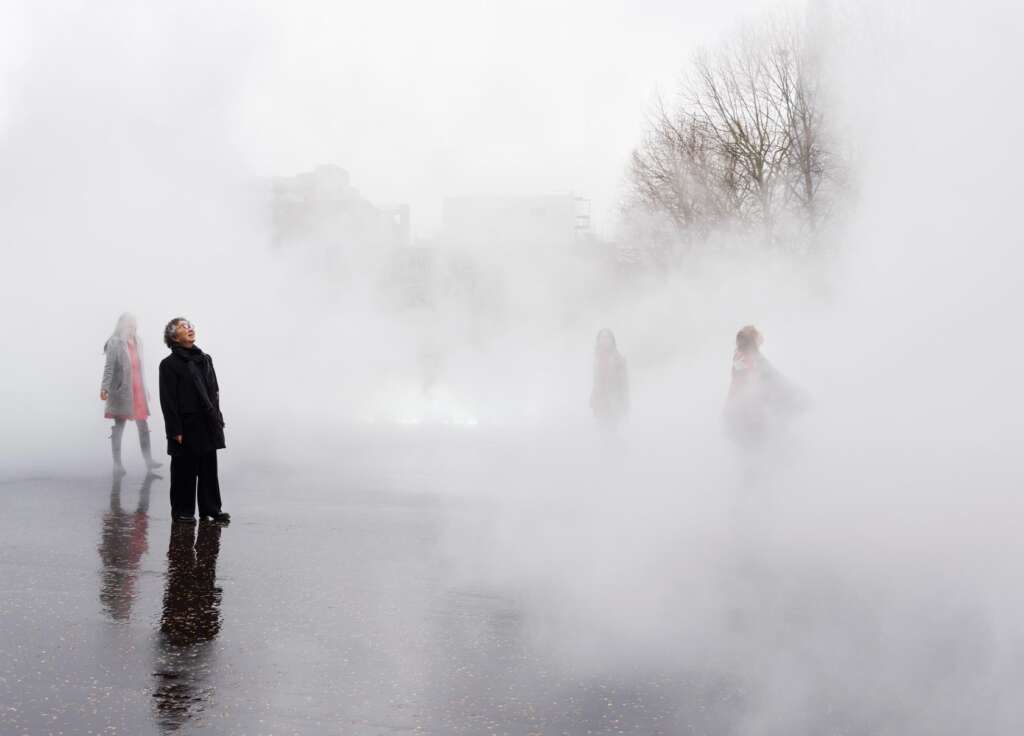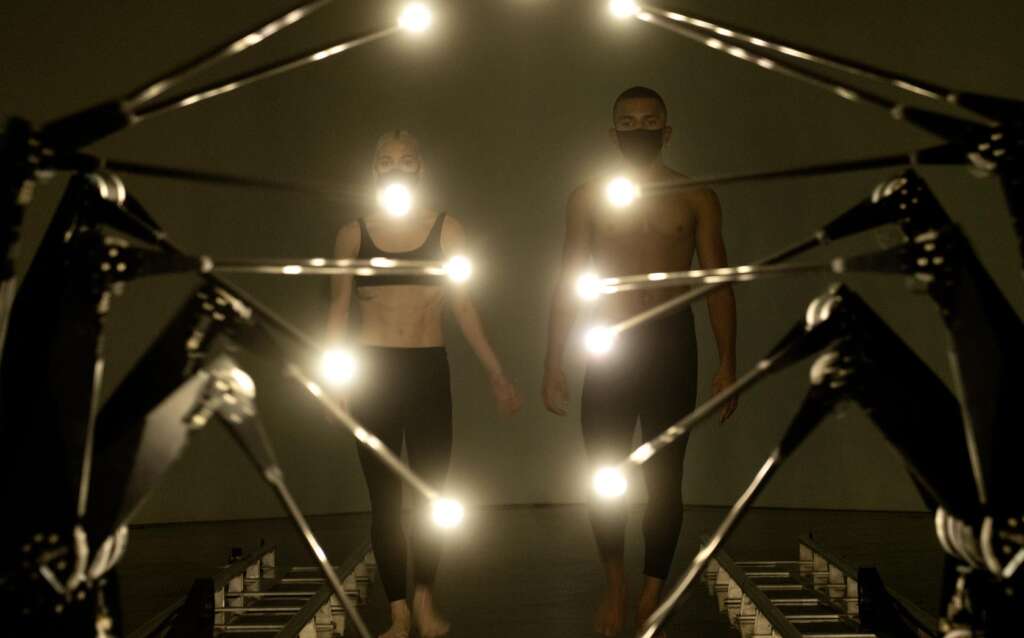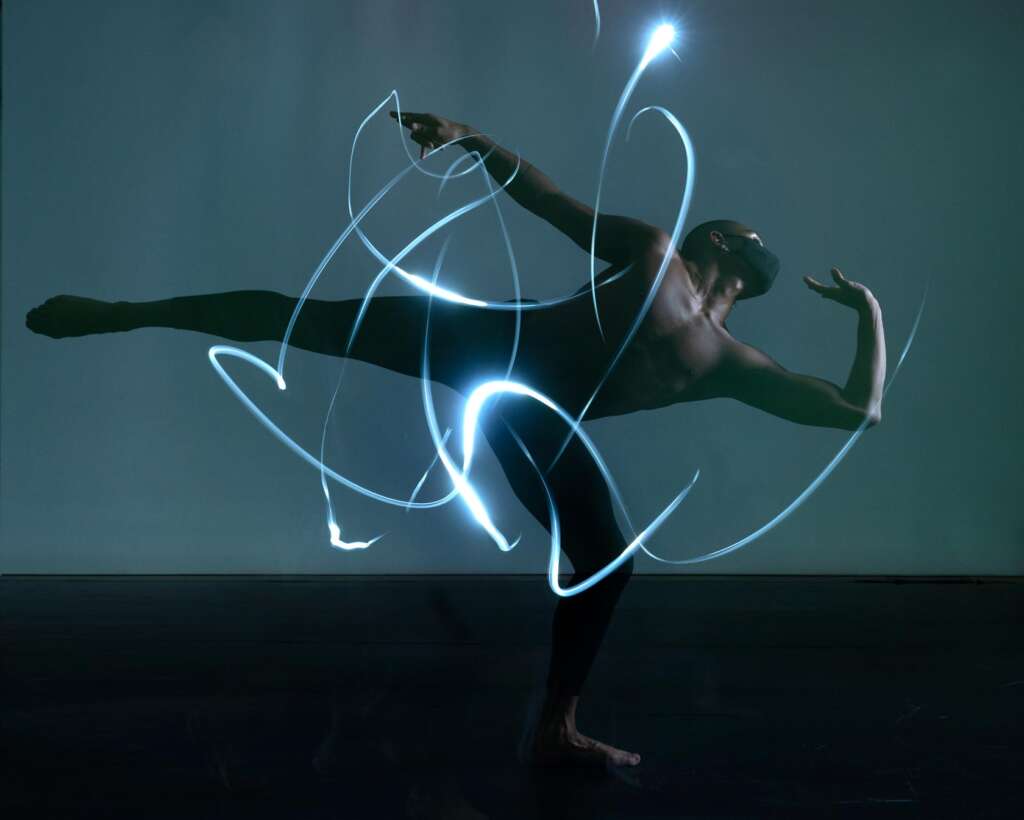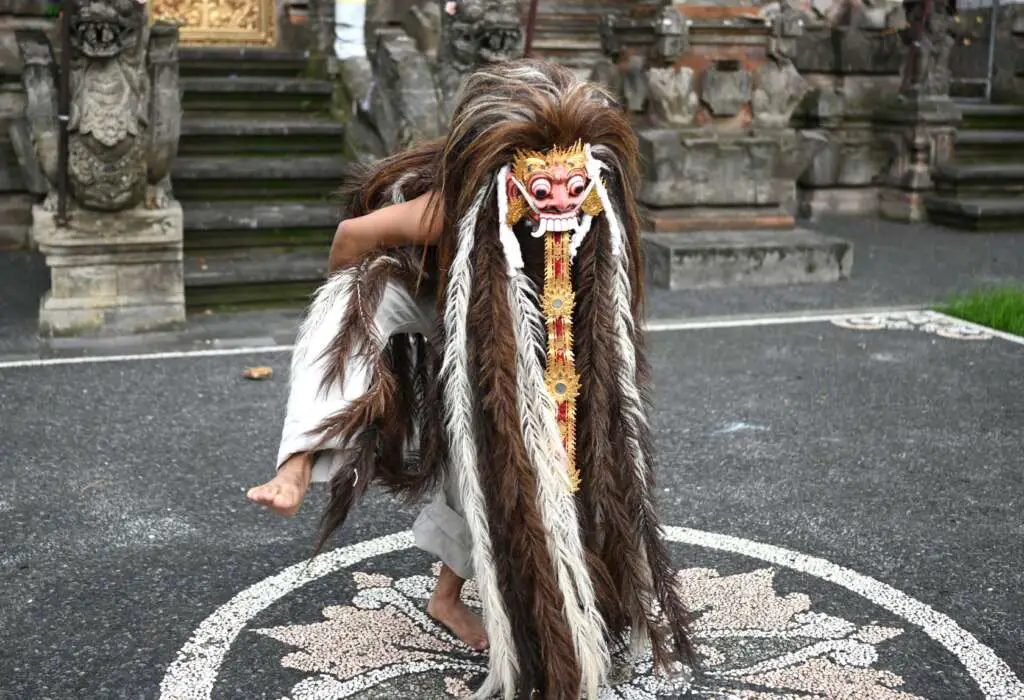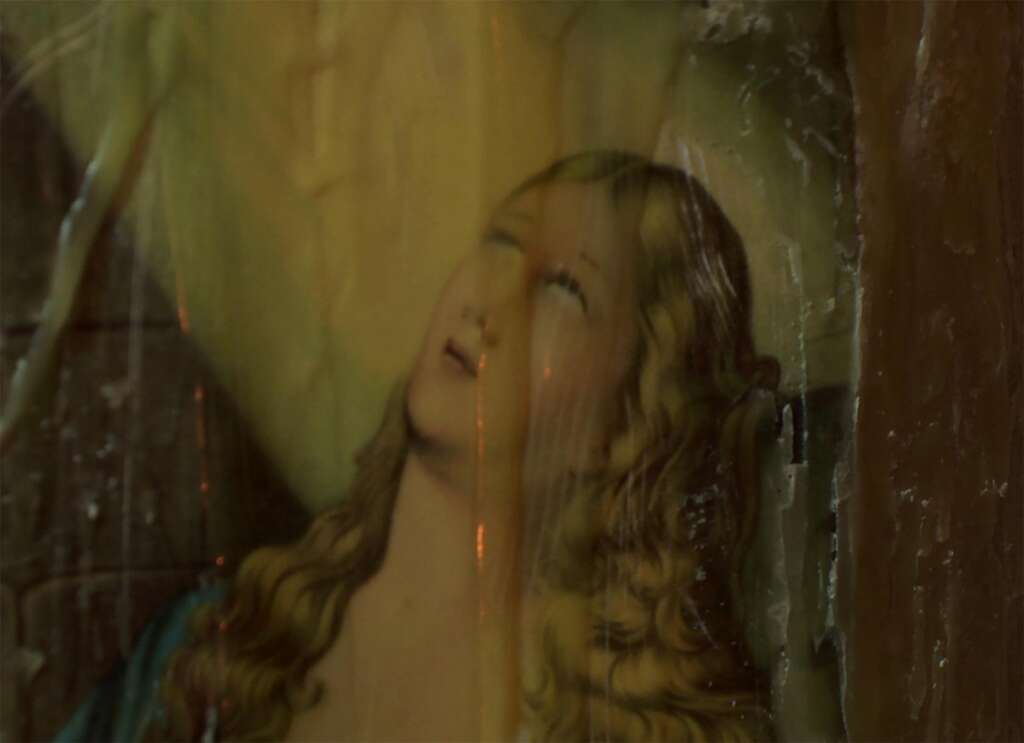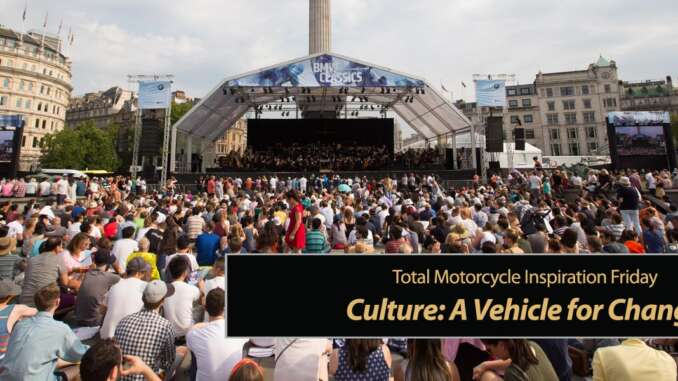
Total Motorcycle invites readers to expand their horizons and minds with our Inspiration Friday: Culture a vehicle for change this week. Culture on a global scale. Get ready to blow your mind with singing, dancing, and spreading the love. Messages of hope and joy from around the world celebrate 50 years of BMW Group’s cultural engagement with over 100 initiatives in the fields of modern and contemporary art, classical music, jazz and sound as well as architecture and design. And this is just a taste of what riders can explore around Europe and the globe.
TMW highlights some of these cultural events that is guaranteed to shock, awe and inspire you today.
All this sounds so 2019 when people roamed the streets, restaurants, clubs and pubs freely but no, this is now and happening and you can experience it in person with tens of thousand of others, live. Not on Zoom or on social media but being immersed in the sounds, smells and socialness of the moment.
From the Guggenheim Museum to Tate Modern, from the Centre Pompidou to the Neue Nationalgalerie. From the opera house Staatsoper Unter den Linden and Milan’s La Scala to Moscow’s Bolshoi Theatre. From Art Basel to Frieze and the Kochi-Muziris Biennale. Corporate citizenship and intercultural dialogue are at the core. Unconditional creative freedom and sustainable and long-term cooperations are essential for true partnerships in the cultural realm. Shared expertise, network and knowledge enable an interaction instead of the monetary transaction that defines mere sponsorship.
From visionary virtual and augmented reality (AR) artworks, to “No One is an Island” about how future generations will interact with automated and digitized processes and environments whilst embracing reduction and sustainability… and to a disturbing week of excess that runs from so-called “Fat Thursday” abandonment of prevailing mores. The broad range of those participating includes important personalities from every cultural sector – from artists, musicians and designers to curators, gallery owners and museum directors as well as to collectors and race drivers.
Total Motorcycle would like to thank BMW for inspiring us to bring you this week’s Inspiration Friday: Culture a vehicle for change. Each week we bring you another Inspiring Motorcycle story to inspire you to get out and ride! Thank you for your support for visiting us and supporting us at Patreon for just $1 a month.
From Ólafur Elíasson, Cao Fei and Stefan Sagmeister to Jonas Kaufmann, Sir Simon Rattle, the Munich Philharmonic and the Teatro dell’Opera di Roma to Esther Mahlangu and Victoria Siddall. TheBMW Group is receiving manifold congratulatory messages from the international cultural world these days, all of them reflecting its long-term and diverse cultural commitment. For 50 years and with over 100 initiatives in the fields of modern and contemporary art, classical music, jazz and sound as well as architecture and design, the BMW Group has been an integral part of culture on a global scale.
It all started with three large-scale paintings by German artist Gerhard Richter commissioned by Eberhard von Kuenheim, then chairman of the board at BMW AG, in 1971. Ever since the opening of the iconic four-cylinder headquarters building by Karl Schwanzer in 1973, the three works titled “Rot”, “Gelb” and “Blau” have been on display within the entrance hall of the company’s headquarters and became the nucleus for the social responsibility of a business enterprise which also engages in intercultural dialogue way beyond its core business.
“Culture is a vehicle for change, the artistic venture takes place at the intersection to the future. This is where BMW risks innovation as well. And while different in content, the underlying attitude is the same. Visualizing ways towards innovation is an integral part of BMW as much as it is of cultural creativity,” said Eberhard von Kuenheim, then chairman of the board at BMW AG, in 1984.
Maximilian Schöberl, Head of BMW Group Corporate and Intergovernmental Affairs and Vice-Chairman of the Board of Spielmotor München e.V. notes, “Especially in times of great societal change, the values of each individual continue to serve as a guideline for their actions. Corporate citizenship is precisely that: it acts as the guiding principle of a company’s value system. What can we return to the society which enables our business success? I am proud to say that the BMW Group, besides maintaining creative freedom at any time, has always continued to pursue an open exchange and intercultural dialogue and is therefore able to enable many long-term and sustainable partnerships.”
It is unique experiences and encounters that promote intercultural dialogue and reflect the principles and attitude of a company within the cultural world. With its broad and diverse network of partners, the cultural commitment of the BMW Group facilitates the creation of current narratives and helps to connect people all across the world – both physically and virtually. As a corporate citizen, the BMW Group believes in the importance of contributing to society in a sustainable way – in the past, present and in the future.
50 years of BMW Group Cultural Engagement – 50 years of encounters
Over five decades, the BMW Group has been engaged in partnerships with some of the most renowned cultural institutions worldwide based on mutual respect and curiosity which makes its cultural commitment a reliable actor in the cultural field. The BMW Group is grateful for a video campaign that shows the congratulatory messages arriving from around the world and will present them via social media throughout the year.
Marc Spiegler, Global Director of Art Basel, which should have celebrated its 50 years of existence last year, sent his congratulations and is looking forward to a double anniversary in 2021, “Now, since we are not going to count 2020, we can celebrate our 50 years together.” Artist Jeff Koons sent his video message including the words, “Animate – inanimate, inside – outside, body – vehicle, DNA – BMW.” Kate Bryan, Head of Collections Soho House, builds miniatures of the BMW Art Car Collection and races them, Hans Ulrich Obrist’s congratulatory message is ended by a seagull, whereas the one by Cao Fei closes with a paradisiac bird-like creature. Jazz musician Hannah Weiss sings “Congratulations” and artist Okuyama Hoseki stops his craftsmanship to send his best wishes from Japan.
The broad range of those participating includes important personalities from every cultural sector – from artists, musicians and designers to curators, gallery owners and museum directors as well as to collectors and race drivers.
BMW Group Cultural Engagement received congratulations from i.a.: Antoniu-Theodor Andreescu (musician), Richard Armstrong (Director, Solomon R. Guggenheim Museum), Margarita Balanas (cellist), Anton Belov (Director, Garage Museum of Contemporary Art), Berlin Biennale, Geoff Blackwell (CEO and publisher, Blackwell & Ruth), Cassy Britton (DJ), Kate Bryan (Head of Collections, Soho House & Co), Astha Butail (artist), Alexandra Catiere (artist), Leelee Chan (artist), Maike Cruse (Director, Gallery Weekend Berlin), Simon Denny (artist), Chris Dercon (President, Réunion des musées nationaux et du Grand Palais des Champs-Élysées), Ken Done (artist), Ólafur Elíasson (artist), Augusto Farfus (race driver), Cao Fei (Artist), Simon Fox (CEO, Frieze), Alex Galmeanu (photographer), Francesca Gavin (writer and curator), Nadine Ghaffar (Founder and General Manager, Art D’Egypte), Venke and Rolf A. Hoff (Founders, KaviarFactory), India Art Fair, Jonas Kaufmann (opera singer), Jeff Koons (artist), Bose Krishnamachari (President, Kochi Biennale Foundation), Marcel Lazăr (musician), William Lim (architect and collector), Esther Mahlangu (artist), Mazaccio & Drowilal (collaborative artist duo), Trevyn and Julian McGowan (Founders, Southern Guild), Zubin Mehta (conductor), Dominique Meyer (CEO, Teatro alla Scala), Andra Mihai (artist), Paul Müller (Executive Director, Munich Philharmonic), Hans Ulrich Obrist (Artistic Director, Serpentine Galleries), Hoseki Okuyama (artist), Shwetal A. Patel (Founding Member, Kochi-Muziris Biennale), Sabin Penea (musician), Madalina Ioana Petre (musician), Georgie Pope (Curator, Independent Collectors), Hervé Poulain (initiator and pilot of the BMW Art Car Collection), Prateek and Priyanka Raja (Founders, Experimenter), Carlo Ratti (Founding Partner, CRA – Carlo Ratti Associati), Sir Simon Rattle (Music Director, London Symphony Orchestra), Magnus Resch (art market entrepreneur), Robin Rhode (artist), Stefan Sagmeister (designer), Philipp Schiepeck (musician), Matthias Schulz (Director, Staatsoper Unter den Linden), Victoria Siddall (Global Director, Frieze Fairs), Roman Sladek (musician), Marc Spiegler (Global Director, Art Basel), Julia Stoschek (Director, Julia Stoschek Foundation), András Szántó (Cultural Strategist), Teatro dell’Opera di Roma, Christoph Wiesner (Director, Le Recontres d’Arles), Lu Yang (artist), Gary Yeh (Founder, ArtDrunk), Samson Young (artist) and Vanessa Zerahn (Independent Collectors).
“Responsibility and reliability are of the greatest value.” The BMW Group celebrates 50 years of global cultural engagement.
Red. Yellow. Blue. Everything started with three large-scale paintings by Gerhard Richter that BMW commissioned from the artist in 1971. Today, BMW is committed to cultural engagement around the world and takes its social responsibility seriously as a corporate citizen. Over a hundred long-term cultural initiatives of the BMW Group in the fields of modern and contemporary art, classical music, jazz and sound as well as in architecture and design have been well established throughout the decades.
Ilka Horstmeier, member of the Board of Management of BMW AG, Director of Human Resources and Labour Relations: “During times of rapid change, responsibility and reliability are of the greatest value. As is culture. For half a century now, we have firmly established our cultural commitment around the world as long-term partners. At the BMW Group, we believe that our arts cooperations are an integral part of our social sustainability – in the past, present and future. It is with utmost joy that the BMW Group can look back on 50 years of incomparable partnerships based on mutual appreciation which connect us to the world’s most renowned cultural institutions and artists.”
From the Guggenheim Museum to Tate Modern, from the Centre Pompidou to the Neue Nationalgalerie. From the opera house Staatsoper Unter den Linden and Milan’s La Scala to Moscow’s Bolshoi Theatre. From Art Basel to Frieze and the Kochi-Muziris Biennale. Corporate citizenship and intercultural dialogue are at the core of a successful business enterprise such as the BMW Group. Unconditional creative freedom and sustainable and long-term cooperations are essential for true partnerships in the cultural realm. Shared expertise, network and knowledge enable an interaction instead of the monetary transaction that defines mere sponsorship.
1971 – Gerhard Richter receives commission of three large-scale paintings
The BMW Group laid the foundation of its cultural commitment with the commissioning of three large-scale works by German artist Gerhard Richter. In 1971, he was asked by Eberhard von Kuenheim, then chairman of the board at BMW AG, to create three paintings for the foyer of the newly built headquarters in Munich. Ever since the opening of the iconic four-cylinder building by architect Karl Schwanzer in 1973, the three commissioned works “Rot”, “Gelb” and “Blau” have been on display in its entrance hall.
1973/74 – Plant Dingolfing and exhibitions at BMW Group
From its inception, the company’s cultural commitment was driven by a focus on its employees. In the early 1970s, BMW opened its plant in Dingolfing. Without autobahn access at that time, Dingolfing quickly emerged as an attractive area for skilled staff, as the BMW Group worked hand in hand with cultural institutions to create access to the local art and culture scene. At about the same time, a new gallery exhibiting the art of employees opened up on the premises of the BMW Group in the north of Munich. In addition, an exhibition space was created to present shows such as “The Automobile in Contemporary Art”, which led to cooperations with institutions such as Haus der Kunst and the Pinakotheken, Munich’s renowned museums of fine art.
1975 – The birth of BMW Art Cars
Initiated by French race car driver and art aficionado Hervé Poulain and conceived in collaboration with the founder of BMW Motorsport Jochen Neerpasch, the first BMW Art Car was commissioned when both asked Alexander Calder to design Poulain’s BMW race car in 1975. The idea resulted in a painted BMW 3.0 CSL that was raced at the 24 Hours of Le Mans, where, thanks to its striking exterior, it became an instant favorite with the public. Since then, 19 artists from around the world have created BMW Art Cars on the basis of contemporary BMW race cars and automobiles, including Roy Lichtenstein (1977, BMW 320i), Andy Warhol (1979, BMW M1), Robert Rauschenberg (1986, BMW 635 CSi), Esther Mahlangu (1991, BMW 525i), David Hockney (1995, BMW 850 CSi), Jenny Holzer (1999, BMW V12 LMR), Jeff Koons (2010, BMW M3GT2), Ólafur Elíasson (2007, BMW H2R), John Baldessari (2016, BMW M6 GTLM) and Cao Fei (2017, BMW M6 GT3). These “rolling sculptures” are a fascinating representation at the crossroads of motorsports and design, of art as well as technology.
1979 – One of Germany’s first cultural public- private p artnerships
Together with the city of Munich, the BMW Group founded Spielmotor München e.V., one of Germany’s oldest public-private partnerships. The collaboration aims to establish and further develop the city as a regional and international hub of culture. Gradually, Spielmotor expanded its program to include the Münchener Biennale for new music-theatre in 1988, the experimental theatre festival SPIELART in 1995 and the festival of contemporary dance DANCE in 1998.
Highlights and digitalization
Over the course of the past five decades, the cultural commitment of the BMW Group has grown far beyond the design of BMW Art Cars by renowned artists. It has expanded its portfolio to include renowned musicians such as Daniel Barenboim and Anna Netrebko, who enchanted tens of thousands of listeners at Berlin’s Bebelplatz, as well as young artists such as Samson Young and Leelee Chan, who left their artist’s studios behind to make the entire world their source of inspiration. Together with other partners, the BMW Group developed its own range of initiatives including the BMW Guggenheim Lab, BMW Tate Live, BMW Open Work by Frieze, the BMW Welt Jazz Award, the BMW Art Guide by Independent Collectors, the BMW Art Journey and the free concert series Opera for all in Berlin, Munich, Moscow and London. With the Rolls-Royce Arts Programme and various design cooperations of MINI, all brands of the BMW Group are active agents in the cultural sector. In addition, the BMW Group supports leading museums, art fairs, orchestras, jazz festivals and opera houses around the world. With BMW OPERA NEXT, its digital partnership with Staatsoper Unter den Linden since 2019, the BMW Group has used the opportunities presented by digitalization to open up the world of opera to younger audiences and to make high culture more accessible. Initiatives such as the Art/Tech Grant by Moscow’s Garage Museum of Contemporary Art, hundreds of choreographed drones flying across the night sky over the Gulf of Mexico in collaboration with Studio Drift, the strategic cooperations with Artsy and Acute Art or Cao Fei, who presented her BMW Art Car via App and AR in virtual space, illustrate how the BMW Group as a technology company engages with the digital transformation and will continue to do so with its cultural commitment in the future.
Random International and BMW i present: “No One is an Island”. Digital world premiere of an installation of Random International in collaboration with Studio Wayne McGregor conflating artificial intelligence with the human capacity to empathise.
Presented by Superblue and BMW i, the art group Random International together with choreographer Wayne McGregor and his company collaborate for the online world premiere of “No One is an Island”. It will be shown exclusively on the digital channels of all participating partners in November, December 2020 and January 2021. The first teaser will go online on November 25, 2020 at 6:00 pm (CET). The live performance will take place at a later date in 2021.
Random International, Studio Wayne McGregor, Superblue and BMW i share a passion for pushing boundaries and exploring new territories. All are moved by similar questions about how future generations will interact with automated and digitised processes and environments whilst embracing reduction and sustainability. For this purpose, they are collaborating on a special project: “No One is an Island”.
“No One is an Island” is fuelled by science and explores electrified movement steered by advanced algorithms. It is a future-oriented reflection on how the human mind empathises with artificial intelligence and automated processes. The performance comprises sculptural, performative and musical elements. The centrepiece is a sculpture that experiments with the minimal amount of information that is actually necessary for an animated form to be recognised as human; and the fundamental impact created by subtle changes within that information. In its transition from robot to human likeness, the sculpture is accompanied by a live performance with dancers of Studio Wayne McGregor who will interact with the kinetics, further exploring the relationship between humans and technology and our capacity to empathise with a machine. The interventions of the dancers scored by Chihei Hatakeyama add a performative dimension to the sculpture, re-translating and celebrating the connection between human and mechanical movement.
“Catalysed by the partnership with BMW i and the collaboration with Studio Wayne McGregor, we have elevated our ongoing ‘Fifteen Points’ series of sculptures to a whole new level. Through the addition of both a score by Chihei Hatakeyama and dedicated choreography by Wayne McGregor, we are able to explore in much more detail the as-of-yet unknown territories of ’empathy with machines’. The work is part of a wider reflection on our human need to relate to our surroundings; how does such a need to connect play out in light of an increasing automation and digitisation of our environment? Will our willingness to engage with unknown systems leave us more vulnerable? We are much looking forward to present the work in a series of live performances in 2021,” says Hannes Koch, one of the founders and directors of Random International about the collaboration.
“What I find inspiring about the partnership with Random International, Superblue, BMW i and myself is that we all come together from different knowledge sets, but convene in areas of shared interest,” says Wayne McGregor. “We are all fascinated by the potential of the human body, its relationship with and to technology but most importantly our desire to generate empathetic connections between people. This is a dialogue of inter-connectedness, exploration and surprise. We have no pre-determined road map – instead, we feed from one another’s expertise and ideas to push ourselves towards new horizons.”
Inspired by Pablo Picasso’s light drawings the dancers create lines of light – capturing movement and electricity visually and re-creating elements from the core of BMW i. Conceptualised as a “Gesamtkunstwerk”, “No One is an Island” is developed in an ongoing dialogue and exchange between artists, choreographer, Random International, Superblue and BMW i.
Mollie Dent-Brocklehurst, Co-Founder and CEO of Superblue says, “Creating new platforms and opportunities for experiential artists to collaborate is core to Superblue’s mission, so we are delighted to partner on this project and creative dialogue between Random International, Studio Wayne McGregor, and BMW i. ‘No One is an Island’ provokes questions about the dynamics between technology and humanity that are critical to deepening our understanding of our relationship to the world and each other.”
The online premiere is split in three chapters, each focusing on either sculpture, dancers or BMW i. All of them will be shared on Instagram and Facebook by Random International @randominternational, Studio Wayne McGregor @studiowaynemcgregor, Superblue @superblue.art and BMW @bmw, @bmwi, and @bmwgroupculture.
“We believe that working together with great artists like Random International, represented by Superblue, and Studio Wayne McGregor is an inspiring and enriching experience for all parties involved. Speaking of BMW i, the constant exchange with creatives is essential. And just as BMW i embodies innovation, ‘No One is an Island’ synergises future and present, technology and humanity,” says Stefan Ponikva, Vice President BMW Brand Experience.
BMW i is standing for sustainable, future-oriented and forward-looking mobility. Engaging in such a creative collaboration is a way to underline this.
BMW announces collaboration with Acute Art to realize a project with BMW Art Journey awardee Lu Yang. Lu Yang presents latest artworks in Art Basel’s “OVR: Miami Beach”.
In cooperation with Acute Art and as long-term global partner of Art Basel, BMW will showcase the latest artworks of Lu Yang, BMW Art Journey awardee of 2019. The Shanghai-based artist is represented by Société, Berlin. From December 2 to 6, 2020, Art Basel will present “OVR: Miami Beach”, the latest edition of the show’s Online Viewing Rooms. The digital platform will feature galleries accepted to the 2020 edition of Art Basel Miami Beach and will be accompanied by a program of online events, including talks and gallery walk-throughs.
In collaboration with Acute Art, leading producer of visionary virtual and augmented reality (AR) artworks, and Lu Yang, BMW will present a new AR work where “DOKU”, the artist’s digital avatar, takes over the physical world in the form of a giant dancing superhero. The installation, titled “Gigant DOKU”, is developed by a game engine and incorporates motion capture image data from Tokyo and Bali gathered during the artist’s BMW Art Journey. The Augmented Reality Experience is available on Acute Art App. Please find the instructions for the app at the end of this text.
„For me as an artist who has been working on digital art projects for many years now, it is a great honor to gain the possibility of working with Acute Art. They are the leading producer of visionary AR artworks and have been working with so many successful artists in the field of AR before. During my BMW Art Journey, I had the chance to cooperate with different artists from several backgrounds and to deepen my research in motion capture technologies – knowledge and material that I can now use for my artworks. Even though I had to pause my travels due to the coronavirus, I am thankful that I am now able to proceed digitally, with the full support and creative freedom provided by the BMW Group,” says Lu Yang.
“We are so excited to work with Lu Yang, one of China’s most prominent young artists, who explores new immersive media to create poetic works that bridge the disciplines. The BMW Art Journey ‘Human Machine Reverse Motion Capture Project’ demonstrates his keen interest in the anthropology of dance into the virtual sphere employing cutting-edge motion-capture technology and robotics. Due to the global pandemic, his physical voyage to Indonesia, India, and Japan had to be adjusted but through a collaboration with Acute Art his dancing avatars can travel across the world digitally. AR makes interactive versions of his dancing figures possible, the first of which will be launched on the Acute Art app in conjunction with ‘OVR: Miami Beach’. Anyone who has downloaded the free app can interact with this dematerialized dancer and place him anywhere, film him and share his performance with friends globally. For an artist concerned with how the human body can overcome its physical limitations, this AR project represents an important step into the era of virtual art and curation,” says Daniel Birnbaum, Artistic Director, Acute Art.
The hard-edged, kinetic animations and paintings of Lu Yang (b. 1984) deploy the latest digital tools to fuse Chinese cultural and spiritual influences with distinctive imagery inspired by manga comics, contemporary youth and gaming subcultures. Trained at the China Academy of Art in Hangzhou, and continuing to undertake studies in robotics, the artist is equally at home with traditional dance and performance practices as with futuristic notions about an emerging post-gender and post-human society in which the lines between the objective and metaphysical world are completely blurred. His distinctive body of work is an example of strikingly new visions emerging from a young generation of artists in today’s technologically advanced China.
Lu Yang’s BMW Art Journey entitled “Human Machine Reverse Motion Capture Projec” examines how the human body can be trained to overcome its physical limitations and explores its deployment in historical and present-day cultures. His research looks into how humans negotiate their evolving relationship with machines that may ultimately surpass human limitations. During his trip to Bali, Indonesia, in January 2020, Lu Yang employed sophisticated motion-capture devices to record dancer’s gestures, including facial, finger- and eye-capture techniques. These latest technological devices collected and analyzed the subtlest body movements and can mimic them using robotic technologies.
All works on view in “OVR: Miami Beach” relate to and are inspired by Lu Yang’s BMW Art Journey, which has continued in the digital realm after the novel coronavirus made it difficult to visit some of the originally planned destinations. More broadly, the selected works highlight the artist’s creative evolution in recent years, leading up to a current body of work in which Lu Yang’s digital avatar has become the subject of his continuing digital journey. Together, the works transport viewers into a fictional universe like no other, in which centuries-old philosophical concerns about what it means to be human are investigated in a hypnotic, cohesive and often disquieting visual language.
All digital artworks of Lu Yang will be accessible for VIPs and public in “OVR: Miami Beach” from December 2, 10am ET, to December 6, midnight ET, via the following link: https://www.artbasel.com/events/detail/17306
To fully discover and experience the interactive artwork of Lu Yang “Gigant DOKU” (from December 2, 10am ET), the Acute Art app is available free of charge on the App Store or Google Play. To start the experience, please see the instructions below:
1. Scan the QR code (in the PDF attached) using your smartphone and download the Acute Art App via the App Store or Google Play.
2. Open the Acute Art app and select “Lu Yang”.
3. Select “Gigant DOKU” and then the “place” button.
4. Point your phone towards the floor and tap to place the work. Drag your finger across the screen to rotate it.
The Acute Art app uses cutting-edge technology that works best on high-end phones with the latest software. The devices supported are iPhone X or above, and Samsung Galaxy S8 or equivalent. The app requires a phone with a minimum of 4GB of memory and Apple iOS 11 or Android 8.0 Oreo (API 24) operating system.
Pauline Curnier Jardin: “Fat to Ashes”. Preis der Nationalgalerie presents solo exhibition after the end of the lockdown at Hamburger Bahnhof Berlin with BMW as exclusive partner.
Meat, skin, wax, confetti, blood, intestines, odors, senses, smoke, ritual, alcohol, excess, touch, singing, fat, and ashes: these are some of the soft, rough, gentle, and coarse materials the artist Pauline Curnier Jardin employs in her works. The winner of the Preis der Nationalgalerie 2019 presents the extensive video installation “Fat to Ashes”, which she produced for her first institutional solo exhibition in Germany, in the historic hall of Hamburger Bahnhof – Museum für Gegenwart – Berlin. The exhibition runs from the reopening of the museums of Berlin onwards until September 19, 2021. BMW supports the Preis der Nationalgalerie as exclusive partner for 15 years now.
“Fat to Ashes” combines three cinematic snapshots: a religious festival in honor of Saint Agatha; the slaughter of a pig; and the Cologne Carnival. Thereby, the exhibition’s title denotes the week of excess that runs from so-called “Fat Thursday” or “giovedì grasso” and known as “Weiberfastnacht” or “Fettdonnerstag” in German, until Ash Wednesday which marks the day reality sets back in and Lent begins according to the Christian Calendar. Jardin shows these three spheres of activity as places of transgression and transformation which bring societal functions originating in cult rituals into the present: those of congregating together, performative display, and the exuberant abandonment of prevailing mores.
An Italian dessert, for example, which recreates the shape of a breast and is eaten on the feast day commemorating the martyrdom of Saint Agatha. The slaughter of the pig takes place far from industrial factory-farming on a traditional rural farm. The images of the Cologne Carnival, on the other hand, are full of life. Looking back at the carnival events, the festivities read like a last great collective debauchery just before Covid would lead to a country-wide lockdown, as people viewing the film today now know. A broad amphitheater encompasses the video installation as the center of the spectacle, and thus transformations, processions, and practiced performance in ritualized excess are the content and formal attributes of Pauline Curnier Jardin’s “Fat to Ashes”.
A catalogue in German and English will be published by Buchhandlung Walther König to mark the exhibition, with contributions by Pauline Curnier Jardin, Sara Giannini, Ana Teixera Pinto, Kristina Schrei and Giovanna Zapperi.
The Preis der Nationalgalerie is enabled by the Freunde der Nationalgalerie since 2000 to reward the winner with a solo exhibition as well as an accompanying publication. The Preis der Nationalgalerie focuses on young important positions of today. Artists of all nationalities are eligible if they are currently working in Germany and are less than 40 years old. Previous awardees amongst others were Monica Bonvicini (2005), Cyprien Gaillard (2011), Anne Imhof (2015), and Agnieszka Polska (2017).

Michael Le Pard (“Mr. Totalmotorcycle”) is the Founder of Total Motorcycle, the world’s largest motorcycle information site, trusted by over 430 million riders since 1999. With over 34 years of experience in motorcycles, gear and rider culture, he has built a global community dedicated to empowering and inspiring motorcyclists.
Total Motorcycle remains his passion project. Combining expert research, hands‑on knowledge and a commitment to helping riders make informed decisions about bikes, gear and safety worldwide.


